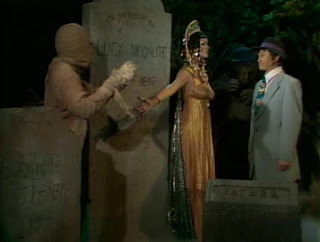In 1975, a live-action Saturday morning television show called The Ghost Busters debuted (nine years before the unrelated movie coincidentally called Ghostbusters). Produced by Filmation, it starred Larry Storch as Spencer, Bob Burns as Tracy, and Forrest Tucker as Kong (collectively known as Spencer, Tracy & Kong, Ghost Busters). Spencer was a zoot-suiter, Tracy was a gorilla, and Kong was the one in charge.
The three of them worked in a dingy office on the tenth floor of a building that was presumably shaped like the Flatiron Building (considering three of the walls had an exterior ledge).
To receive their Ghost Buster assignments, Kong would send Spencer and Tracy to a general store across town (with Tracy at the wheel of a 1929 Whippet) to retrieve it in the form of an audio tape concealed in a random object, which, after playing a message from someone named Zero, would self-destruct in usually five seconds.
Invariably, their mission was to intercept a ghost or two and send them back to the Great Beyond. The ghosts were drawn like magnets to the same cemetery every week, and they would inevitably decide to take residence in what they called a castle (which is confusing because it resembled a castle from the inside, but its exterior appeared to be a creepy mansion).
Dispatching a ghost typically involved zapping it with the Ghost De-Materializer, but occasionally it required fulfilling other conditions specific to the ghost.
Ghosts, in general, seemed to be more substantial as they were incapable of passing through solid matter and frequently interacted with physical objects. They could, however, teleport, which they did frequently, and some could turn invisible. Some had unique powers, such as the mummy's ability to transform any mortal it touched into a mummy.
Could The Ghost Busters be adapted to a role-playing game using the rules of Ghostbusters: A Frightfully Cheerful Roleplaying Game? It can! The question ought to be, "Should it?" We'll do it anyways.
Welcome to The Ghost Busters: A Clever, Courageous, and Strong Role-Playing Game That Is Completely Unofficial. (The title makes sense if you've heard the theme song.)
And here are the titular characters...
Spencer
Brains 2 (Ventriloquism 5)Muscles 3 (Flee 6)
Moves 3 (Music 6)
Cool 4 (Impersonate Celebrities 7)
Goal: Fame
Tracy the Gorilla
Brains 2 (Magic 5)Muscles 7 (Intimidate 10)
Moves 2 (Art 5)
Cool 2 (Prop Comedy 5)
Goal: Fame
Kong
Brains 3 (Library Science 6)Muscles 3 (Flee 6)
Moves 3 (Aim Ghost De-Materializer 6)
Cool 3 (Boss Others 6)
Goal: Wealth
Between the three, they have a jalopy for transportation, a Ghost Kit (including a Ghost De-Materializer), a wide assortment of hats for Tracy, a few books, many filing cabinets, an antique typewriter, an antique telephone, and various art supplies (again, for Tracy).
ZAP!








